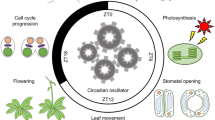Summary
By quantitative analysis of cellulose microfibril orientation at different levels in the primary cell wall of a number of cell types, the development of wall texture was studied. Meristematic, isodiametric and cylindrical parenchyma cells and cells of a suspension culture were used. Within the newly deposited microfibril population, various orientations were recognized on the micrographs. Within subpopulations the orientation of undercrossing and overcrossing microfibrils were measured. These measurements showed a gradual shift in cellulose microfibril orientation in the different levels. Microfibrils showed predominant orientations at particular levels but microfibrils of intermediate orientation also occurred, although at a much lower density. As cellulose microfibrils of intermediate orientation were not closely packed, lamellae were not formed. Interwoven microfibrils were occasionally present, indicating that differently orientated microfibrils are occasionally deposited simultaneously. Also gradual changes in orientation over the entire inner cell wall surface were observed. From these observations it was inferred that microfibril deposition occurs with a small but regular and progressive change in orientation, the rotational motion, related to that of a helicoidal system.
Similar content being viewed by others
References
Abe H, Ohtani J, Fukazawa K (1991) FE-SEM observations on the microfibrillar orientation in the secondary wall of tracheids. IAWA Bull 12: 431–438
Amstel ANM van, Kengen HMP, Oostendorp CECM, Sassen MMA (1989) Freeze-fracturing and dry-cleaving of cells and protoplasts ofNicotiana sp. Cell wall texture. In: Fifth Cell Wall Meeting, 30.8.-2.9. 1989, Edinburgh, United Kingdom, 161
Emons AMC (1988) Methods for visualizing cell wall texture. Acta Bot Neerl 37: 31–38
Harada H, Côté WA (1985) Structure of wood. In: Higuchi T (ed) Biosynthesis and biodegradation of wood components. Academic Press, Orlando, pp 1–42
Hasezawa S, Syono K (1983) Hormonal control of elongating of tobacco cells derived from protoplasts. Plant Cell Physiol 24: 127–132
Juniper BE, Lawton JR, Harris PJ (1981) Cellular organelles and cell wall formation in fibres from the flowering stem ofLolium temulentum L. New Phytol 89: 609–619
Kishi K, Harada H, Saiki H (1979) An electron microscopy study of the layered structure of the secondary wall in vessels. Mokuzai Gakkaishi 25: 521–527
Lang JM, Eisinger WR, Green PB (1982) Effects of ethylene on the orientation of microtubules and cellulose microfibrils of pea epicotyl cells with polylamellate cells walls. Protoplasma 110: 5–14
Liese W (1965) The warty layer. In: Côté WA (ed) Cellular ultra-structure of woody plants. Syracuse University Press, Syracuse, pp 117–127
McCann MC, Wells B, Roberts K (1990) Direct visualization of cross-links in the primary plant cell wall. J Cell Sci 96: 323–334
Mueller SC, Brown RM (1982) The control of cellulose microfibril deposition in the cell wall of higher plants. I. Can directed membrane flow orient cellulose microfibrils? Indirect evidence from freeze-fractured plasma membranes of maizes and pine seedlings. Planta 154: 489–500
Nagata T, Okada K, Takebe I, Mitsui C (1981) Delivery of tobacco moisaic virus RNA into plant protoplasts mediated by reversephase evaporation vesicles (liposomes). Mol Gen Genet 184: 161–165
Neville AC (1986) The physics of helicoids. Multidirectional “plywood” structures in biological systems. BioEssays 37: 74–77
—, Levy S (1984) Helicoidal orientation of cellulose microfibrils inNitella opaca internode cells: ultrastructure and computed theoretical effects of strain reorientation during wall growth. Planta 162: 370–384
— — (1985) The helicoidal concept in plant cell wall ultrastructure and morphogenesis. In: Brett CT, Hillman JR (eds) Biochemistry of plant cell walls. Cambridge University Press, Cambridge, pp 99–124 (SEB Seminar 28)
Parameswaran N, Liese W (1981) Occurrence and structure of polylamellate walls in some lignified cells. In: Robinson DG, Quader H (eds) Cell walls ′81. Wissenschaftliche Verlagsgesellschaft, Stuttgart, pp 171–188
Preston RD (1974) The physical biology of plant cell walls. Chapman and Hall, London
Roland JC (1981) Comparison of arced patterns in growing and non-growing polylamellate cell walls of higher plants. In: Robinson DG, Quader H (eds) Cell walls ′81. Wissenschaftliche Verlagsgesellschaft, Stuttgart, pp 162–170
—, Mosiniak M (1983) On the twisting pattern, texture and layering on the secondary cell walls of lime wood. Proposals of a unifying model. IAWA Bull 4: 15–26
—, Vian B, Reis D (1975) Observations with cytochemistry and ultracryotomy of the fine structure of the expanding walls in actively elongating plant cells. J Cell Sci 19: 239–259
— — — (1977) Further observations on cell wall morphogenesis and polysaccharide arrangement during plant growth. Protoplasma 91: 125–141
—, Reis D, Vian B, Satiat-Jeunemaitre B, Mosiniak M (1987) Morphogenesis of plant cell walls at the supramolecular level: internal geometry and versatility of helicoidal expression. Protoplasma 140: 75–91
—, Reis D, Vian B (1993) The cell walls of cholesteric type: nucleation of defects in the structural order related with spherical cells. Acta Bot Neerl 42: 101–110
Sassen MMA, Wolters-Arts AMC (1992) Cell wall texture in shoot apex cells. Acta Bot Neerl 41: 25–29
—, Traas JA, Wolters-Arts AMC (1985) Deposition of cellulose microfibrils in cell walls of root hairs. Eur J Cell Biol 37: 21–26
Satiat-Jeunemaitre B, Martin B, Hawes C (1992) Plant cell wall architecture is revealed by rapid-freezing and deep-etching. Protoplasma 167: 33–42
Vian B, Reis D (1991) Relationship of cellulose and other cell wall components: supramolecular organization. In: Haigier HC, Weimer PJ (eds) Biosynthesis and biodegradation of cellulose. Marcel Dekker, New York, pp 25–50
Wilms FHA, Wolters-Arts AMC, Derksen, J (1990) Orientation of cellulose microfibrils in cortex cells of tobacco expiants: effects of microtubule-depolymerizing drugs. Planta 182: 1–8
Wolters-Arts AMC, Sassen MMA (1991) Deposition and reorientation of cellulose microfibrils in elongating cells ofPetunia stylar tissue. Planta 185: 179–189
Author information
Authors and Affiliations
Additional information
Dedicated to Professor Dr. M. M. A. Sassen on the occasion of his 65th birthday
Rights and permissions
About this article
Cite this article
Wolters-Arts, A.M.C., van Amstel, T. & Derksen, J. Tracing cellulose microfibril orientation in inner primary cell walls. Protoplasma 175, 102–111 (1993). https://doi.org/10.1007/BF01385007
Received:
Accepted:
Issue Date:
DOI: https://doi.org/10.1007/BF01385007




